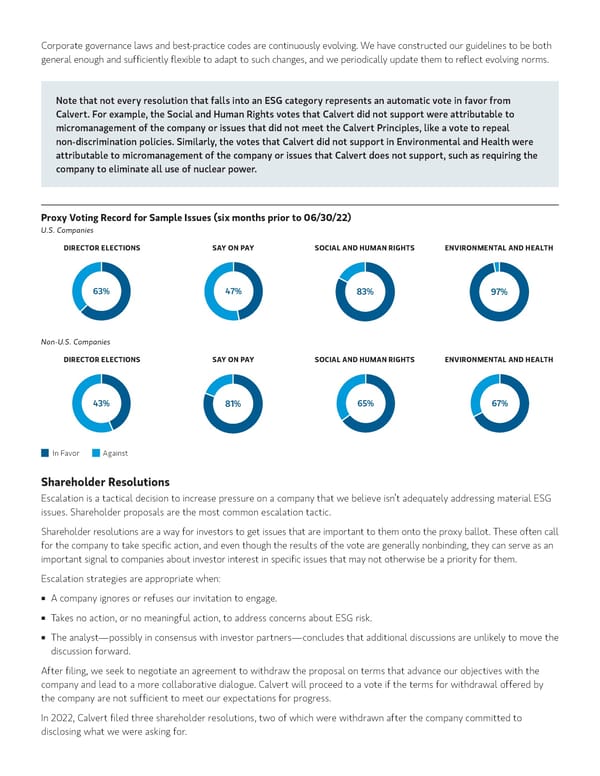Corporate governance laws and best-practice codes are continuously evolving. We have constructed our guidelines to be both general enough and sufficiently flexible to adapt to such changes, and we periodically update them to reflect evolving norms. Note that not every resolution that falls into an ESG category represents an automatic vote in favor from Calvert. For example, the Social and Human Rights votes that Calvert did not support were attributable to micromanagement of the company or issues that did not meet the Calvert Principles, like a vote to repeal non-discrimination policies. Similarly, the votes that Calvert did not support in Environmental and Health were attributable to micromanagement of the company or issues that Calvert does not support, such as requiring the company to eliminate all use of nuclear power. Proxy Voting Record for Sample Issues (six months prior to 06/30/22) U.S. Companies DIRECTOR ELECTIONS SAY ON PAY SOCIAL AND HUMAN RIGHTS ENVIRONMENTAL AND HEALTH 63% 47% 83% 97% Non-U.S. Companies DIRECTOR ELECTIONS SAY ON PAY SOCIAL AND HUMAN RIGHTS ENVIRONMENTAL AND HEALTH 43% 81% 65% 67% In Favor Against Shareholder Resolutions Escalation is a tactical decision to increase pressure on a company that we believe isn’t adequately addressing material ESG issues. Shareholder proposals are the most common escalation tactic. Shareholder resolutions are a way for investors to get issues that are important to them onto the proxy ballot. These often call for the company to take specific action, and even though the results of the vote are generally nonbinding, they can serve as an important signal to companies about investor interest in specific issues that may not otherwise be a priority for them. Escalation strategies are appropriate when: „ A company ignores or refuses our invitation to engage. „ Takes no action, or no meaningful action, to address concerns about ESG risk. „ The analyst—possibly in consensus with investor partners—concludes that additional discussions are unlikely to move the discussion forward. After filing, we seek to negotiate an agreement to withdraw the proposal on terms that advance our objectives with the company and lead to a more collaborative dialogue. Calvert will proceed to a vote if the terms for withdrawal offered by the company are not sufficient to meet our expectations for progress. In 2022, Calvert filed three shareholder resolutions, two of which were withdrawn after the company committed to disclosing what we were asking for.
 Calvert Tools of Change Page 6 Page 8
Calvert Tools of Change Page 6 Page 8